- Sorry, this product is unavailable.
-

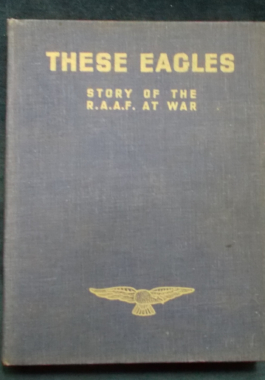 With stories, sketches and photographs from the servicemen and women of the Royal Australian Air Force. No 'Boys Own' adventures here - these are real tales of man's condition, actions and reactions in wartime. From Out Of Control: To watch Mother Earth rushing up to meet you while you are fighting a spine at a mere few thousand feet does not increase your expectation of a long and useful life... There's the ground crew blokes, the high-altitude men, the U-boat spotters, the Old New Contemptibles; the ladies of the W.A.A.A.F get a salute from the boys. There's even cartoons - such as one would expect from an Aussie view of things. Illustrated with sketches, black and white photographs and colour plates.
With stories, sketches and photographs from the servicemen and women of the Royal Australian Air Force. No 'Boys Own' adventures here - these are real tales of man's condition, actions and reactions in wartime. From Out Of Control: To watch Mother Earth rushing up to meet you while you are fighting a spine at a mere few thousand feet does not increase your expectation of a long and useful life... There's the ground crew blokes, the high-altitude men, the U-boat spotters, the Old New Contemptibles; the ladies of the W.A.A.A.F get a salute from the boys. There's even cartoons - such as one would expect from an Aussie view of things. Illustrated with sketches, black and white photographs and colour plates. -
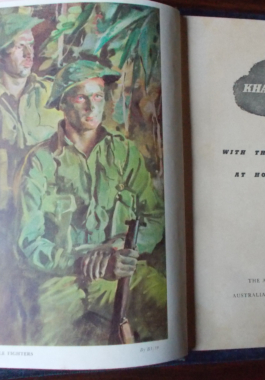
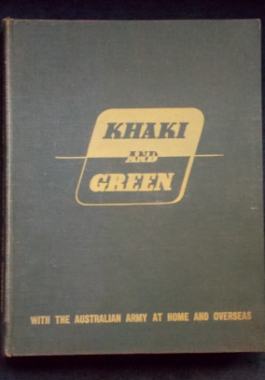
With the Australian Army at Home and Overseas. Published for the Australian Military Forces by the Australian War Memorial, Canberra, 1943. With news and information - literally - as it happened from the Middle East and the South West Pacific. Chapters and writings include: Alamein Christmas Shops; Luck and Gus; I Saw a Panzer Attack; The Log Which Wasn't; Moon Madness; Survival of the Fairest; No Mates in the Army and much more, all written by Australia's Own. With stories, yarns, cartoons, poems, fabulous colour plates, black and white illustrations and photographs. Real war history.
-
 Illustrated with over 1300 photographs, some never previously published, this military journey begins with the build up to war and the invasion of Poland to ultimate victory over Japan. Immensely readable, it brings the events and the people of those turbulent times into sharp focus for those who lived through the conflict as well as those born during the fifty years that have elapsed since the war's end.
Illustrated with over 1300 photographs, some never previously published, this military journey begins with the build up to war and the invasion of Poland to ultimate victory over Japan. Immensely readable, it brings the events and the people of those turbulent times into sharp focus for those who lived through the conflict as well as those born during the fifty years that have elapsed since the war's end. -
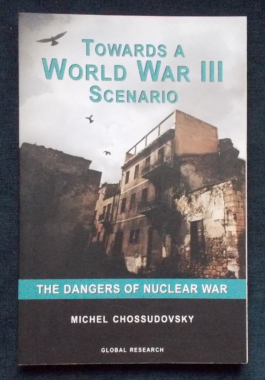 The author is a Professor of Economics and Director of the Centre for Research on Globalisation. This book has been rated and reviewed as a "...'must' resource - a richly documented and systematic diagnosis of the...planning of U.S. Wars since 9-11" "...one of the most important books currently available...the information is heart rending, scary and absolutely accurate." ...a hard-hitting and compelling book (which) explains why and how we must undertake a concerted...campaign to head off the impending cataclysmic demise of the human race and planet Earth."
The author is a Professor of Economics and Director of the Centre for Research on Globalisation. This book has been rated and reviewed as a "...'must' resource - a richly documented and systematic diagnosis of the...planning of U.S. Wars since 9-11" "...one of the most important books currently available...the information is heart rending, scary and absolutely accurate." ...a hard-hitting and compelling book (which) explains why and how we must undertake a concerted...campaign to head off the impending cataclysmic demise of the human race and planet Earth." -
 A volume of military activity, weaponry and technology from 1987. Arenas of activity covered: The Middle East - Tripoli; Lebanon; the Gulf War; South Yemen and the Arab-Israeli conflict. Europe, North America and the Soviet Union: Terrorism and Power Politics; The Superpower Relationship; NATO and the Warsaw Pact; International Terror; Northern Ireland. Asia - Islam's Guerrillas; The Tamil Tigers; The Philippines; Vietnam and Cambodia' Sikh Separatists. Africa - South Africa; Mozambique; Angola; Chad; The Sudan; Ethiopia; The Boy Soldiers of Uganda. Latin America: Guerrillas and Contras; El Salvador; Nicaragua; Peru; Chile. Military Technology: The War Machine; Aerial Warfare; Space and Missiles; Land Warfare; Naval Warfare. A wealth of information for the war history buff with plenty of colour photographs.
A volume of military activity, weaponry and technology from 1987. Arenas of activity covered: The Middle East - Tripoli; Lebanon; the Gulf War; South Yemen and the Arab-Israeli conflict. Europe, North America and the Soviet Union: Terrorism and Power Politics; The Superpower Relationship; NATO and the Warsaw Pact; International Terror; Northern Ireland. Asia - Islam's Guerrillas; The Tamil Tigers; The Philippines; Vietnam and Cambodia' Sikh Separatists. Africa - South Africa; Mozambique; Angola; Chad; The Sudan; Ethiopia; The Boy Soldiers of Uganda. Latin America: Guerrillas and Contras; El Salvador; Nicaragua; Peru; Chile. Military Technology: The War Machine; Aerial Warfare; Space and Missiles; Land Warfare; Naval Warfare. A wealth of information for the war history buff with plenty of colour photographs. -
 Shot down in 1942, young Australian fighter pilot John Williams DFC became a POW in the notorious Stalag Luft III camp in Germany. John had joined the air force shortly before the outbreak of war and, in the larrikin tradition, led his squadron into air combat over the deserts of Libya and Egypt dressed in sandals and shorts. John and his best mate Rusty Kierath were among the 76 POWs who tunnelled their way out of the supposedly escape-proof camp under the noses of their German guards in what later became the Hollywood blockbuster, The Great Escape. Their families never learned what really happened once the pair made it out into the forest. John's niece Louise Williams has pieced together his life, from his upbringing in a tight-knit family hit hard by the Depression, to his exploits in the air, and the many missing details of the tragic escape. It is a powerful and intimate story of one of the most dramatic episodes of World War II. Illustrated with black and white photographs.
Shot down in 1942, young Australian fighter pilot John Williams DFC became a POW in the notorious Stalag Luft III camp in Germany. John had joined the air force shortly before the outbreak of war and, in the larrikin tradition, led his squadron into air combat over the deserts of Libya and Egypt dressed in sandals and shorts. John and his best mate Rusty Kierath were among the 76 POWs who tunnelled their way out of the supposedly escape-proof camp under the noses of their German guards in what later became the Hollywood blockbuster, The Great Escape. Their families never learned what really happened once the pair made it out into the forest. John's niece Louise Williams has pieced together his life, from his upbringing in a tight-knit family hit hard by the Depression, to his exploits in the air, and the many missing details of the tragic escape. It is a powerful and intimate story of one of the most dramatic episodes of World War II. Illustrated with black and white photographs. -
 Who is Captain Sir Tom Moore? You've seen him on the television walking the length of his garden. A frail elderly man, doing his bit at a time of crisis. But he wasn't always like this. From a childhood in the foothills of the Yorkshire Dales, Tom Moore grew up in a loving family, which wasn't without its share of tragedy. It was a time of plenty and of want. When the storm clouds of the Second World War threatened, he raised his hand and like many of his generation, joined up to fight. His war would take him from a country he had never left to a place which would steal his heart, India and the Far East, to which he would return many years later to view the sight he had missed first time around: the distant peak of Everest. Captain Tom's story is our story. It is the story of our past hundred years here in Britain. It's a time which has seen so much change, yet when so much has stayed the same: the national spirit, the can-do attitude, the belief in doing your best for others. Illustrated with photographs.
Who is Captain Sir Tom Moore? You've seen him on the television walking the length of his garden. A frail elderly man, doing his bit at a time of crisis. But he wasn't always like this. From a childhood in the foothills of the Yorkshire Dales, Tom Moore grew up in a loving family, which wasn't without its share of tragedy. It was a time of plenty and of want. When the storm clouds of the Second World War threatened, he raised his hand and like many of his generation, joined up to fight. His war would take him from a country he had never left to a place which would steal his heart, India and the Far East, to which he would return many years later to view the sight he had missed first time around: the distant peak of Everest. Captain Tom's story is our story. It is the story of our past hundred years here in Britain. It's a time which has seen so much change, yet when so much has stayed the same: the national spirit, the can-do attitude, the belief in doing your best for others. Illustrated with photographs. -
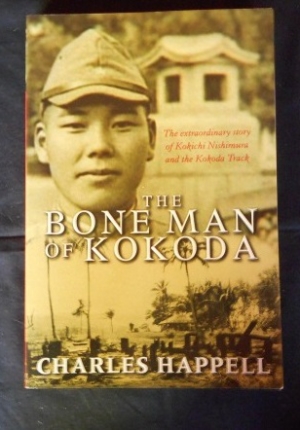
Kokichi Nishimura was a member of the 2nd battalion, 144th regiment of the Japanese Imperial Army. In 1942 he fought every foot of the Kokoda Track as the Japanese attempted to take Port Moresby and was the only man from his platoon to survive the campaign. Finally he retreated, wounded and starving, leaving thousands of his comrades buried in shallow graves along the Track. He promised that he would one day return to them and bring them home to Japan for proper burial. He married, had three children and started an engineering business which prospered. But his driving ambition was to return to New Guinea to keep his promise. In 1979, nearing retirement age, he shocked his family by giving his business to his sons, his house and all his assets to his wife and he returned to New Guinea to begin his search for the remains of Japanese soldiers. For the next 25 years Nishimura lived alone in huts and tents along the Kokoda Track and using a mattock, a shovel, a metal detector and an indomitable will, he found the bones of hundreds of his comrades and also forged a new comradeship and new purpose in helping the poverty-stricken Papuans he worked amongst. An incredible story. Illustrated with black and white photographs.




